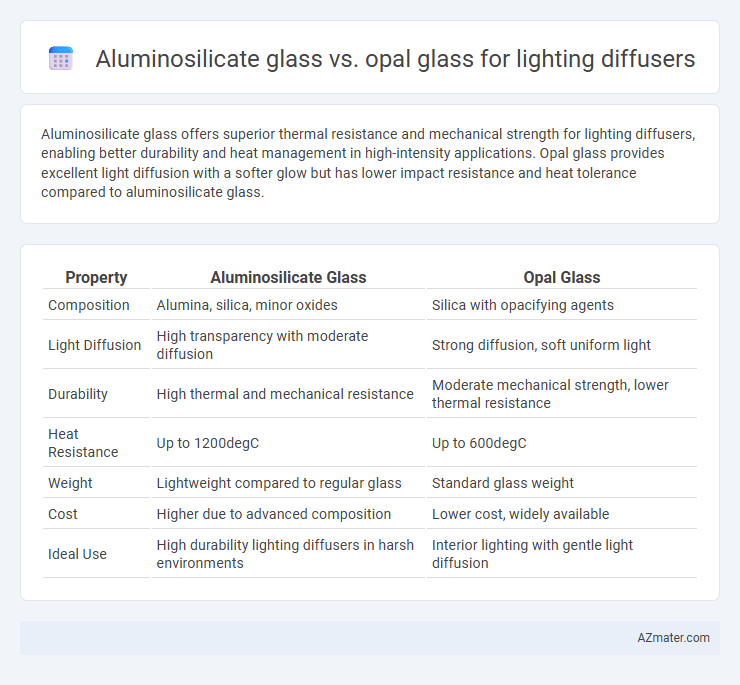Aluminosilicate glass offers superior thermal resistance and mechanical strength for lighting diffusers, enabling better durability and heat management in high-intensity applications. Opal glass provides excellent light diffusion with a softer glow but has lower impact resistance and heat tolerance compared to aluminosilicate glass.
Table of Comparison
| Property | Aluminosilicate Glass | Opal Glass |
|---|---|---|
| Composition | Alumina, silica, minor oxides | Silica with opacifying agents |
| Light Diffusion | High transparency with moderate diffusion | Strong diffusion, soft uniform light |
| Durability | High thermal and mechanical resistance | Moderate mechanical strength, lower thermal resistance |
| Heat Resistance | Up to 1200degC | Up to 600degC |
| Weight | Lightweight compared to regular glass | Standard glass weight |
| Cost | Higher due to advanced composition | Lower cost, widely available |
| Ideal Use | High durability lighting diffusers in harsh environments | Interior lighting with gentle light diffusion |
Introduction to Lighting Diffuser Materials
Aluminosilicate glass offers high thermal resistance and mechanical strength, making it ideal for lighting diffusers in high-temperature applications. Opal glass, characterized by its milky white appearance, provides excellent light diffusion and softens the emitted light, enhancing visual comfort. The choice between aluminosilicate and opal glass depends on specific lighting requirements such as heat tolerance, optical clarity, and diffusion efficiency.
Overview of Aluminosilicate Glass
Aluminosilicate glass is a high-strength material known for its excellent thermal and chemical stability, making it ideal for lighting diffusers exposed to heat and harsh environments. Its high resistance to impact and scratches ensures durability and longevity in various lighting applications. Compared to opal glass, aluminosilicate glass offers superior mechanical performance while maintaining excellent light diffusion properties.
Properties of Opal Glass
Opal glass, known for its translucent milky-white appearance, provides superior light diffusion by softening and evenly dispersing illumination, reducing glare and hot spots better than aluminosilicate glass. Its high thermal stability and excellent chemical resistance make it ideal for LED lighting applications, ensuring long-term durability under fluctuating temperatures. Opal glass also exhibits enhanced whiteness and uniform light transmission, contributing to improved aesthetic and functional qualities in lighting diffusers.
Light Transmission and Diffusion Comparison
Aluminosilicate glass offers high light transmission rates, typically exceeding 90%, making it ideal for clear, bright lighting diffusion applications, while its excellent thermal and mechanical properties enhance durability. Opal glass, conversely, provides superior light diffusion due to its milky, translucent surface that scatters light uniformly, resulting in softer illumination but with reduced transmission, usually between 70% and 85%. The choice between aluminosilicate and opal glass hinges on balancing maximum light output with the desired level of diffusion and aesthetic softness in lighting design.
Durability and Strength Differences
Aluminosilicate glass exhibits superior durability and strength compared to opal glass, making it more resistant to thermal shock and mechanical stress in lighting diffuser applications. The enhanced chemical composition of aluminosilicate glass provides higher impact resistance and better performance under high-temperature conditions. Opal glass, while aesthetically pleasing with its diffuse light properties, is generally more brittle and susceptible to cracking under mechanical strain.
Thermal and Chemical Resistance
Aluminosilicate glass offers superior thermal resistance with a high softening point around 1650degC, making it suitable for lighting diffusers exposed to intense heat or rapid temperature changes. Its excellent chemical durability resists alkali and acidic corrosion, ensuring longevity in harsh environments. Opal glass, while providing good light diffusion properties, has a lower thermal resistance with a softening point near 720degC and is more susceptible to chemical degradation, limiting its use in high-temperature or chemically aggressive settings.
Aesthetic and Design Considerations
Aluminosilicate glass offers superior clarity and a smooth, glossy finish that enhances modern and minimalist lighting designs with its high transparency and resistance to thermal shock. Opal glass provides a soft, diffused light effect with a matte surface, creating uniform illumination and reducing glare, ideal for achieving warm, ambient aesthetics. Designers prioritize aluminosilicate glass for sleek, contemporary fixtures, while opal glass is favored in applications requiring gentle light diffusion and cozy atmospheres.
Cost and Availability
Aluminosilicate glass offers high durability and thermal resistance but generally comes at a higher cost and limited availability compared to opal glass. Opal glass is more widely available and cost-effective for lighting diffusers, providing excellent light diffusion with moderate durability. Budget-conscious projects typically favor opal glass due to its lower price point and easier procurement.
Application Suitability in Lighting
Aluminosilicate glass offers superior thermal and mechanical strength, making it ideal for high-intensity and outdoor lighting diffusers where durability and heat resistance are critical. Opal glass provides excellent light diffusion with a uniform soft glow, preferred in indoor applications requiring aesthetic appeal and glare reduction. The choice between aluminosilicate and opal glass hinges on the specific lighting environment, with aluminosilicate suited for demanding conditions and opal glass optimized for decorative and ambient lighting.
Conclusion: Choosing the Right Diffuser Material
Aluminosilicate glass offers superior thermal resistance and mechanical strength, making it ideal for high-performance lighting diffusers requiring durability and heat endurance. Opal glass provides excellent light diffusion and aesthetic appeal with softer, more uniform illumination, preferred in residential and decorative lighting applications. Selecting the right diffuser material depends on balancing thermal durability with light quality, where aluminosilicate suits industrial environments and opal glass excels in design-focused lighting.

Infographic: Aluminosilicate glass vs Opal glass for Lighting diffuser
 azmater.com
azmater.com